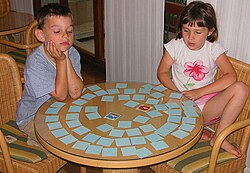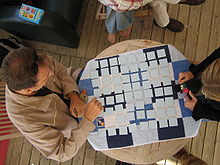Memory (game)
| Memory | |
|---|---|
 Children playing a memory game |
|
| Game data | |
| author | William Hurter |
| graphic | Manfred Burggraf |
| publishing company | Ravensburger |
| Publishing year | 1959 |
| Art | Memory game |
| Teammates | 2 to 10 |
| Duration | 30 minutes |
| Age | from 4 years |
Memory (after English memory , memory ') is one of Ravensburger registered trademark for a known board game after the Pairs principle: Couples same, hidden resting cards must be detected by revealing the change of players.
Origin and Success
The Ravensburger Memory is inspired by the “twin game” by the author Berta von Schroeder , which had no commercial success and was also not the first version of the game. This game came to the Swiss military attaché William Hurter in London in 1946 . After his return to Switzerland, the folding card game, which he further developed, was first published in 1959 by Verlag Otto Maier in Ravensburg (today Ravensburger Spieleverlag ), after an attempt to publish the game at Edition Carlit was unsuccessful because Edition Carlit already had a similar game with the name Punta led. The long-time publishing director and game expert Erwin Glonnegger said of the origin of the name :
“When I asked him (Hurter) what is the name of the game, he said: Well, yes, we don't have a real name for it, in Basel the game is called“ Zwillingsspiel ”, but the neighborhood children, when they always came about the game, or when they wanted to play, they said: Let's play your memory game. So I said: we have a title, we'll take it. "
The Ravensburger Memory, of which more than 50 million units have been sold in 70 countries to date, is described by the publisher as its greatest success.
Tournaments
There are now regular tournaments . In the tournament, 64 cards (32 pairs) are usually played from the game set from “Children's memory”. Since the memory game contains 33 pairs, one pair is sorted out from this for tournaments (according to the tournament rules, the fire engine). The winners are determined in group and knockout rounds. The German Memory Championship has been held annually since 1990 as part of the international game days in Essen in October. There are also regular tournament events in some federal states. Memory players in Germany have joined forces in the “Society of Friends of the Memory Game”.
In 1992/1993 the Ravensburger Verlag organized a series of qualification tournaments in several European countries. The respective national champions met in January 1993 for the European Memory Championship in Weingarten . The winners were Philipp Hiller-Hufnagel in the children's category and Rainer Husel in the adult category , both from Germany.
The Memory brand
Memory is colloquially used as a generic name for other games based on a similar game principle. At times, other providers also used the name for their games.
In Germany, Ravensburger AG owns the registered word mark “MEMORY” in the leading class 28 for the goods / services of playing card games. In addition, since 1999, it has also owned the “Memory” word mark in the leading class 09 for “games recorded on data carriers of all kinds” and laying card games. The "MEMORY" brand for games and toys is registered internationally. Ravensburger uses the brand in different variants in upper and lower case.
In order to protect its trademark, the publisher took action against improper use in more than one hundred cases between 1999 and 2004, according to the APA . According to a decision by the Austrian Supreme Court in decision 4 Ob128 / 04h , the view that the disputed label “memory” is “common property for which no equivalent alternative term is available” cannot be accepted.
precursor
The game idea itself, which is not patentable, has existed for several centuries; see pairs . The following names are known:
- Kai-Awase (貝 合 わ せ ), 12th century, Japan
- Pairs and Pelmanism , 19th Century, England and USA.
- Twin game , 1940s, Bertha von Schroeder, Switzerland.
- Punta , 1950s, Edition Carlit.
- Merkfix , 1970s, VEB Plasticart, GDR.
- Pexeso, 1965, ČSSR
Digital versions, for example on cell phones, usually use the unprotected term Pairs .
Topics (selection)
There are now numerous card variants of Memory, which are dedicated to specific, closed topics:
- Memory Germany
- Nature memory
- Memory Europe
- Time travel memory, 1959–2009: The special feature is the unevenly designed cards that juxtapose objects from 1959 and 2009
- Tiptoi Memory (Digital)
variants
The game MemoCards, in which triples of three (differently shaped) cards can be found.
In the case of digital versions of pairs , you often play alone against the stopwatch and the attempts are counted. It is important to find all pairs as quickly as possible and with a few attempts. Often you can choose from different "sets" of cards.
Mathematical analysis
From the point of view of mathematical game theory , memory is a zero-sum game with perfect information . With only two players, each position has a clearly determined value, which is the expected value of the excess of winning pairs of the currently drawing player in a game that is error-free on both sides. The error-free game does not only refer to remembering cards that have already been revealed. Rather, memory allows strategic influence. This refers in particular to the fact that as a second card, sometimes not by chance, uncovering an as yet unknown card. The reason for such an approach is that in certain situations the advantage achieved is too small due to the low probability of a chance hit compared to the risk of providing the opponent with information about the position of a complete pair.
A complete recursive analysis of the two-person memory was first published in 1993 by Uri Zwick and Michael Paterson, the results having previously been found by Sabih Gerez in 1983 without publication. Since in some very late endgame situations a mutually destructive behavior would be optimal, in which both players only reveal known cards, the tournament rules have been adjusted accordingly.
literature
- Erwin Glonnegger : The game book: board and placement games from all over the world; Origin, rules and history . Uehlfeld: Drei-Magier-Verlag, 1999. ISBN 3-9806792-0-9
Web links
- Memory in the game database BoardGameGeek (English)
- Memory (1946) in the Luding games database
- Memory tournament, memo techniques, strategies
- GFMS, Society of Friends of the Memory Game
- Ravensburger doesn't have fun with memory copies. Enforcement of trademark rights in Austria
- rhetorik.ch Documentation of brand law arguments
- Pairs as a Seed7 program
- Rainer Schiefer: Memory, an almost indescribable success story. In: Alte Spiele - Modernes Spiele-Antiquariat. Ulrike Schiefer, accessed on June 22, 2012 .
- Deutschlandfunk Kultur, interview with game researcher Jens Junge: 60 years of memory games - a challenge for everyone. Retrieved April 15, 2019 .
Individual evidence
- ↑ http://www.nzzformat.ch/109+M514328b9a6c.html
- ↑ http://www.ulrich-willmes.de/memory-abmaahrung.html Documentation of a warning due to the use of the term "memory"
-
↑ Uri Zwick, Michael S. Paterson: The Memory game , Theoretical Computer Science, Volume 110, Issue 1, 1993, pp. 169-196, doi: 10.1016 / 0304-3975 (93) 90355-W ( preprint ).
See also Jörg Bewersdorff : Luck, Logic and Bluff: Mathematics in Play - Methods, Results and Limits , Vieweg + Teubner Verlag, 5th edition 2010, ISBN 3834807753 , doi: 10.1007 / 978-3-8348-9696-4 , p. 217-223 - ^ Sahih H. Gerez: English Summary of the Report in Dutch "An Analysis of the" Memory "Game", 65-Afternoon Project Report, University of Twente, Department of Electrical Engineering, 1983 (PDF; 19 kB)
- ↑ General information on tournament memory
